
Starting in 1937, plates became ‘permanent’- motorists received a date tab upon yearly renewal, instead of new plates as had been done in the past. These thick aluminum plates were used for 10 years.
Several variations were made towards the end of this series. During the wartime, plates were made of steel rather than aluminum. Some of the plates have the back side painted red, others a tan color, while later ones are painted gray. The first number of these plates (upper left digit) ranged from 2 through 7.
Next, in 1946, aluminum again became available and plates resumed in the pre-war style. These started late in the ‘7’ series and the first plates of this style had silver paint over the aluminum. The aluminum plates continued through the ‘8’ series, soon returning to the bare-aluminum style. Late in 1946 or early 1947, brass was used for the plates. This was excess material from the war effort. However, the paint did not adhere to these plates well at all. This, in conjunction with the softness of the brass, makes decent examples of these plates hard to find today. The first digit on these brass plates is ‘9’.
In 1947 the state went back to aluminum yet again. Perhaps realizing that the 10-year run of these plates was nearly up, a very thin aluminum was used. These plates bent and became damaged very easily, and also suffered from corrosion. Decent examples of this type are hard to find as well. These plates have a letter over a number for the first two digit. Some 1947 tabs on renewed registrations were made of brass.
New base plates were issued starting with the ’48 expiration. These were reflective, with a yellow scotchlite coating. The prongs on the tabs were reversed. Unfortunately, this material did not hold up well on the roads and flaked off the plates. Many of these plates are missing the reflectorization completely.
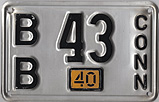 1940
1940
This base was used from 1937 through 1947.
The little date tab in the center was replaced every year.
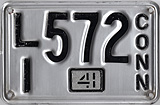 1941
1941
 1942
1942
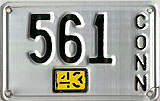 1943 Low Number
1943 Low Number
 1944.
1944.
The tabs during wartime were not aluminum, so they were subject to rusting and flaking paint.
 1945
1945
Steel plate
 Still using steel plates nearing the end of the ‘7’ series.
Still using steel plates nearing the end of the ‘7’ series.
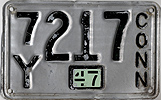 1946
1946
Back to thick aluminum plates. Unlike the earlier thick aluminum plates, these were painted silver.
 Eventually the thick aluminum plates were unpainted on the front.
Eventually the thick aluminum plates were unpainted on the front.
(Plate shown in issue order, not expiration order)
 1946
1946
Near the end of the ‘8’ series.
 1947
1947
Brass plates started in the ‘9’ series. It appears that most or all of the ‘9/A’ series are reflectorized over a brass base plate. With the ‘9/B’ series the brass was painted silver.
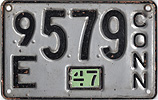 1947
1947
Another Brass plate
 Reverse of the brass plate
Reverse of the brass plate
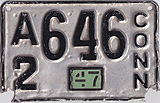 1947 Thin aluminum plate.
1947 Thin aluminum plate.
The thin plates started in the A/2 series and presumably ran through Z/2 before moving on to A/3. The thin plates were not very durable.
 1947
1947
Thin aluminum plate. It is difficult to find examples of this plate style which are this nice.
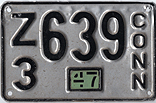 1947 Thin aluminum plate.
1947 Thin aluminum plate.
These plates apparently ran from A/3 through the end of the Z/3 series.
 1947
1947
Brass tab on renewed registration plate. Much like the paint didn’t stick to the brass plates, it didn’t stick to the brass tabs either.
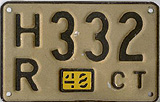 1948 – New aluminum plates with reflective yellow ‘scotchlite’ backgrounds were introduced.
1948 – New aluminum plates with reflective yellow ‘scotchlite’ backgrounds were introduced.
 1949
1949